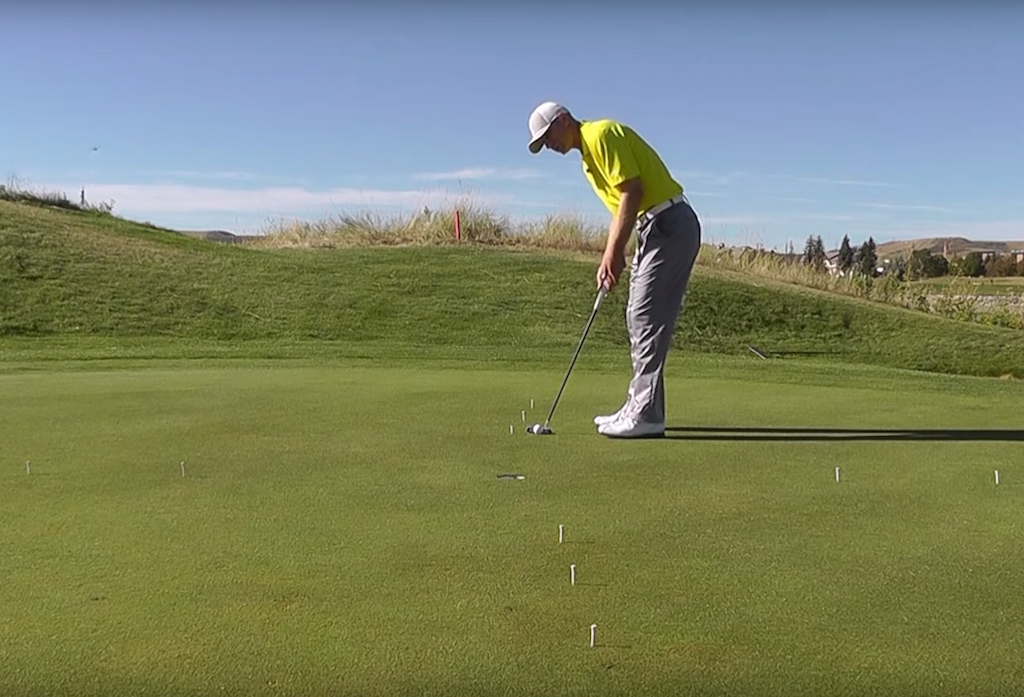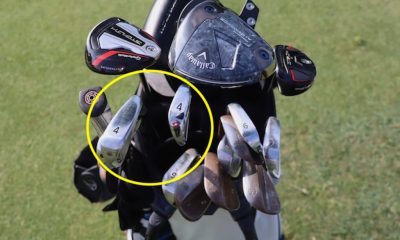Instruction
Game of the Week: Clock

Statistical programs consistently show how important putting is from 4-8 feet. We have a game for you that revolves around that exact vital statistic.
This week’s Game of the Week, called Clock, is a great game that will reduce the pressure that you feel when trying to hole one of these on the course. You can play it over and over again in a short amount of time; so get out there this weekend and do something great for your game, practicing pressure situations with a score present.
Game of the Weekend: Clock
- Gear needed: Putter, 12 tees and 1 ball
- Time needed: Less than 10 minutes, depending on how good you are!
Rules: Set up a tee at each of these distances from the hole: 4 feet, 6 feet and 8 feet. This will make up the “12 o’clock” position. Then set up tees at the same distances at 3 o’clock, 6 o’clock and 9 o’clock. This will give you a total of 12 tees.
Start from the 4-foot tee at 12 o’clock and proceed around in a circle putting from all of the 4-feet tees, followed by the 6-feet tees and finally the 8-feet tees. Add up the number of putts that you holed out of a possible 12 and enter that into the golfscrimmages.com practice website if you wish to track your score.
Benefits: Here’s what this game helps you with.
- Pressure-packed short putts where you’ll either make your money or lose it!
- By alternating positions around the hole, you’ll never get the same break/line twice in a row and that’s vital to your ability to do it the ONE time that we’re allowed on the course.
Practice like you play and play like you practice. Have a great weekend!
More Games
- Game of the Weekend: 100
- Game of the Weekend: Go Low
- Game of the Weekend: Chipping Median
- Game of the Weekend: 18 holes of up-and-down… with a twist
- Game of the Weekend: Drawback
- LIKE16
- LEGIT1
- WOW0
- LOL1
- IDHT0
- FLOP0
- OB0
- SHANK2
Instruction
Clement: Laid-off or perfect fade? Across-the-line or perfect draw?

Some call the image on the left laid off, but if you are hitting a fade, this could be a perfect backswing for it! Same for across the line for a draw! Stop racking your brain with perceived mistakes and simply match backswing to shot shape!
- LIKE0
- LEGIT0
- WOW0
- LOL0
- IDHT0
- FLOP0
- OB0
- SHANK1
Instruction
The Wedge Guy: The easiest-to-learn golf basic

My golf learning began with this simple fact – if you don’t have a fundamentally sound hold on the golf club, it is practically impossible for your body to execute a fundamentally sound golf swing. I’m still a big believer that the golf swing is much easier to execute if you begin with the proper hold on the club.
As you might imagine, I come into contact with hundreds of golfers of all skill levels. And it is very rare to see a good player with a bad hold on the golf club. There are some exceptions, for sure, but they are very few and very far between, and they typically have beat so many balls with their poor grip that they’ve found a way to work around it.
The reality of biophysics is that the body moves only in certain ways – and the particulars of the way you hold the golf club can totally prevent a sound swing motion that allows the club to release properly through the impact zone. The wonderful thing is that anyone can learn how to put a fundamentally sound hold on the golf club, and you can practice it anywhere your hands are not otherwise engaged, like watching TV or just sitting and relaxing.
Whether you prefer an overlap, interlock or full-finger (not baseball!) grip on the club, the same fundamentals apply. Here are the major grip faults I see most often, in the order of the frequency:
Mis-aligned hands
By this I mean that the palms of the two hands are not parallel to each other. Too many golfers have a weak left hand and strong right, or vice versa. The easiest way to learn how to hold the club with your palms aligned properly is to grip a plain wooden ruler or yardstick. It forces the hands to align properly and shows you how that feels. If you grip and re-grip a yardstick several times, then grip a club, you’ll see that the learning curve is almost immediate.
The position of the grip in the upper/left hand
I also observe many golfers who have the butt of the grip too far into the heel pad of the upper hand (the left hand for right-handed players). It’s amazing how much easier it is to release the club through the ball if even 1/4-1/2″ of the butt is beyond the left heel pad. Try this yourself to see what I mean. Swing the club freely with just your left hand and notice the difference in its release from when you hold it at the end of the grip, versus gripping down even a half inch.
To help you really understand how this works, go to the range and hit shots with your five-iron gripped down a full inch to make the club the same length as your seven-iron. You will probably see an amazing shot shape difference, and likely not see as much distance loss as you would expect.
Too much lower (right) hand on the club
It seems like almost all golfers of 8-10 handicap or higher have the club too far into the palm of the lower hand, because that feels “good” if you are trying to control the path of the clubhead to the ball. But the golf swing is not an effort to hit at the ball – it is a swing of the club. The proper hold on the club has the grip underneath the pad at the base of the fingers. This will likely feel “weak” to you — like you cannot control the club like that. EXACTLY. You should not be trying to control the club with your lower/master hand.
Gripping too tightly
Nearly all golfers hold the club too tightly, which tenses up the forearms and prevents a proper release of the club through impact. In order for the club to move back and through properly, you must feel that the club is controlled by the last three fingers of the upper hand, and the middle two fingers of the lower hand. If you engage your thumbs and forefingers in “holding” the club, the result will almost always be a grip that is too tight. Try this for yourself. Hold the club in your upper hand only, and squeeze firmly with just the last three fingers, with the forefinger and thumb off the club entirely. You have good control, but your forearms are not tense. Then begin to squeeze down with your thumb and forefinger and observe the tensing of the entire forearm. This is the way we are made, so the key to preventing tenseness in the arms is to hold the club very lightly with the “pinchers” — the thumbs and forefingers.
So, those are what I believe are the four fundamentals of a good grip. Anyone can learn them in their home or office very quickly. There is no easier way to improve your ball striking consistency and add distance than giving more attention to the way you hold the golf club.
More from the Wedge Guy
- The Wedge Guy: Golf mastery begins with your wedge game
- The Wedge Guy: Why golf is 20 times harder than brain surgery
- The Wedge Guy: Musings on the golf ball rollback
- LIKE88
- LEGIT15
- WOW6
- LOL1
- IDHT0
- FLOP4
- OB1
- SHANK9
Instruction
Clement: Stop ripping off your swing with this drill!

Not the dreaded headcover under the armpit drill! As if your body is defective and can’t function by itself! Have you seen how incredible the human machine is with all the incredible feats of agility all kinds of athletes are accomplishing? You think your body is so defective (the good Lord is laughing his head off at you) that it needs a headcover tucked under the armpit so you can swing like T-Rex?
- LIKE0
- LEGIT3
- WOW2
- LOL0
- IDHT0
- FLOP0
- OB0
- SHANK2
-

 19th Hole3 weeks ago
19th Hole3 weeks agoLET pro gives detailed financial breakdown of first week on tour…and the net result may shock you
-

 19th Hole7 days ago
19th Hole7 days agoReport: LIV star turns down PGA Championship invite due to ‘personal commitments’
-

 19th Hole2 weeks ago
19th Hole2 weeks agoGary Player claims this is what ‘completely ruined’ Tiger Woods’ career
-

 Equipment6 days ago
Equipment6 days agoDetails on Justin Thomas’ driver switch at the Wells Fargo Championship
-

 Whats in the Bag2 weeks ago
Whats in the Bag2 weeks agoTeam McIlowry (Rory McIlroy, Shane Lowry) winning WITBs: 2024 Zurich Classic
-

 Whats in the Bag7 days ago
Whats in the Bag7 days agoKeegan Bradley WITB 2024 (May)
-

 Equipment2 weeks ago
Equipment2 weeks agoGolf fans left surprised by LIV’s choice of course for its 2024 individual championship event
-

 Equipment2 weeks ago
Equipment2 weeks agoWhy Wesley Bryan is playing two 4-irons this week





















Trent Wearner
Oct 2, 2015 at 4:42 pm
Hello All – thanks for the replies and hope you’re having a great day! There are many different twists you can do with each game. My hope is that it inspires practice that is far better than dropping down three golf balls and mindlessly following them around the green. This clock game can be seen on the practice putting greens of every tour event. bg: while I agree the 6footers and 8footers are along the same line as the 4footers, the line the ball would take would not be exactly the same unless the green between the 4 and 6ft putt and the green between the 4 and 8ft putt was perfectly flat. While I would agree that seeing the 4ft putt will help with the 6 and 8ft putts behind it is still effective, beneficial and random, though yes, your version would make it more random. Keep up the good work!
ooffa
Sep 25, 2015 at 11:27 am
Wow, the bar for what qualifies as an instructional article has really been lowered by this post. Just drop balls in random places between 3 and 8 feet from the cup. Count how many you knock in out of ten. TaaaDaaa new putting game.
Drawshank
Sep 25, 2015 at 4:10 pm
Just dropping putts at random distances doesn’t give you any way of monitoring your improvement, your random putts could average 6 feet one week and 8 feet the next, obviously you will generally be better from 6 feet.
What’s the point of an instructional article? I would say it’s to make you better at golf. Providing the instruction works, it doesn’t have to be rocket science, don’t you think?
Trent Wearner
Oct 2, 2015 at 4:44 pm
Agreed – thank you Drawshank.
bg
Sep 25, 2015 at 11:12 am
I feel like an advanced twist on this drill would be to set up a 4′ putt at 12 o’clock, 6′ at 1 o’clock, 8′ at 2 o’clock, 4′ at 3 o’clock… all the way around. This way, you truly are never hitting the same putt twice. Whereas in the drill described above, the 4′-er gives a read for the 6′-er on the same line.